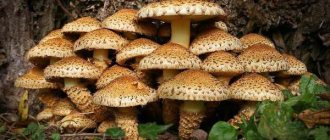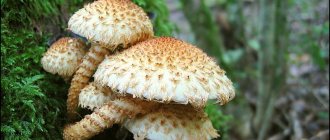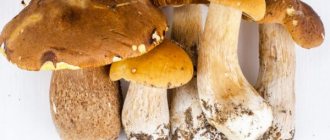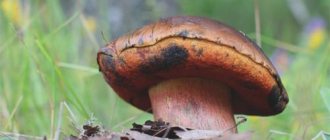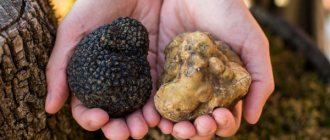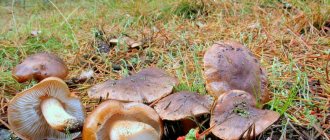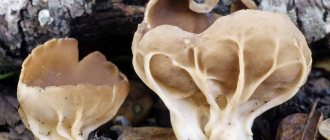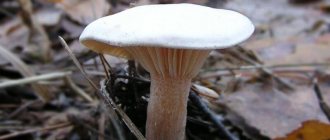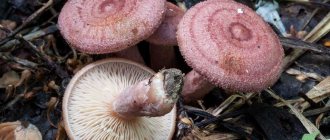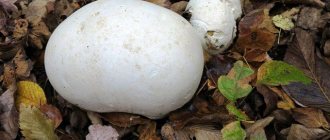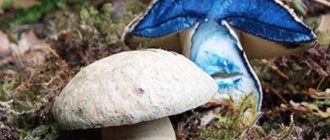Mushroom stitch (Gyromitra
) is an edible crop that begins to bear fruit in the spring, when the forest awakens after its snowy sleep. Not all collectors are familiar with the plant, since the fruiting bodies of this family cannot be called popular. Even experienced mushroom pickers often pass by the line because they don’t know whether it can be eaten. Today we will look at the culture in detail, studying its characteristics, varieties, benefits, as well as cooking methods. Perhaps this information will be useful for you.
Mushroom stitch, appearance + description and photo
Like any mushroom, the stitch has a biological description of its appearance. With its help, it is easy to distinguish the marsupial genus from similar counterparts:
1) Large, rounded cap, has uneven outlines. In size, it can exceed more than 20 cm. The pattern visually resembles convolutions, similar to the structure of the nucleus of a walnut or the brain. Color varies from deep brown to reddish red. Visually resembles the outlines of an eastern headdress - a turban.
2) The leg is short, thick and slightly flattened. Most of it is hidden behind the cap and in the soil. Color - light, white or pale pink. It's hollow inside. It is fragile when pressed.
3) The pulp is smooth and light. It feels like a velvety fabric. If collected incorrectly in a bag or package, it often breaks into dust. It is recommended to collect mushrooms exclusively in baskets or buckets.
4) The aroma is different, depending on the variety and weather. It can repel with a swampy smell of dampness or, on the contrary, attract with mushroom notes.
Due to ignorance of the distinctive features, the string mushroom can easily be confused with a morel. Their unusual appearance is often mistakenly attributed to one genus by newcomers. Morels have a taller stem and an ovoid conical cap with deep cells. Insects and slugs usually live in them. The morel family is completely edible, compared to strings.
Grille red
This type of unusual mushroom is known as the trellis, basket or red net mushroom. So he was nicknamed for his peculiar appearance. The mushroom is considered very rare, and it is listed in the Red Book. But you can find it in dense foliage, humus, tall forest grass or mulch. Only its smell of rotting immediately discourages anyone from trying it, although no one advises this. The grate is inedible.
5
How and where to collect lines?
The first spring mushrooms often germinate in sandy soil. The harvest season in 2022, as in the previous few years, begins in mid-April, continuing fruiting until the end of May. To protect your health, it is not recommended to go hunting when the climate is hot. Elevated temperatures have a detrimental effect on the content of toxins contained in conventionally edible varieties. The same can be said about overgrown mushrooms and myceliums located in contaminated areas. The third variety, although not defective, has a detrimental effect on the body when grown in areas located near city landfills, highways, factories, and cemeteries.
The lines often grow in groups. In rare cases, sprouting of single mushrooms can be seen. Forest fruits are classified as saprophytic organisms growing in pine forests, deciduous and mixed plantings, cleared areas and forests with coniferous litter.
In cold regions with high humidity, they can bear fruit until mid-autumn.
A distinctive feature of the stitches is the inverted base of the cap. Compared to cap mushrooms, Gyromitra forms spores along the entire perimeter of the upper part, which is unusual for most species.
The amount of fat is minimal. Conditionally edible lines can be consumed during a diet and low-calorie diet, including the product in the daily diet of an adult.
Bottom line
The result can be drawn as follows. Mushrooms and mushroom pickers are one whole. Indivisible. Mushroom pickers know absolutely everything about the gifts of the forest and their types. This article will be useful for many professionals and even for inexperienced beginners. We were convinced that the common moth is a poisonous mushroom and very dangerous to human life. Improper preparation of these mushrooms can lead to serious poisoning. In addition, death also occurs. But you can still cook it. The most important thing is to know how.
The lines are truly delicious. They have already been appreciated by many gourmets and ordinary lovers of dishes with mushrooms. By doing everything strictly according to the recipe, you can be absolutely sure that the finished dish will give you only positive emotions. Let this article become a guide and assistant for many mushroom pickers, even the most experienced. And the dishes that were presented here will be a stunning decoration for any table.
Varieties of stitches
In the scientific community, string mushrooms are divided into 4 varieties:
- autumn;
- beam;
- giant;
- ordinary.
Only two are considered edible: Bunch and Giant. They belong to the third class and are included in the category of conditionally edible representatives of their species.
Benefit
Mushrooms contain various substances that make them an excellent ingredient used in folk medicine and provide the following effects:
- maintaining tone;
- pain relief;
- increased appetite;
- stabilization of spleen performance;
- improvement of the digestive tract.
Poisonous varieties
The most toxic and poisonous mushrooms in the marsupial family are:
No. 1 - Ordinary stitch
The harm from using an ordinary stitch has been scientifically proven. Its pulp contains the poison gyromitrin, which persists even after heat treatment. Regardless of the number of boils and drains of water, toxins do not decompose and can cause irreparable harm to the human body.
And if in conditionally edible lines, gyromitrin is destroyed when dried at high temperatures. Contents in large volumes in an ordinary line do not allow the harm to be reduced even to a minimum.
Statistics of poisonings and deaths are more common in Germany than in Russia, Belarus and Ukraine. However, cases of intoxication are still registered. Therefore, doctors prohibit consuming fruit pulp even in small quantities.
Interesting fact!
Until now, many scientists are at a loss as to why the lines collected in the Federal Republic of Germany contain more poison in their pulp than in the regions of Russia and European cities. The only thing that could be confirmed was the increase in gyromitrin due to the place of germination: soil pollution, air pollution and arid climate. Volumes also depend on the strain of the fungus. Scientific studies conducted by German researchers revealed a huge content of gyromitrin per 1 kg of fresh product. Consuming such a volume of stitches can lead not only to poisoning and intoxication, but also to failure of internal organs, resulting in death. There are no such observations in Europe. The minimum content of poison in conditionally edible varieties dissolves under the influence of high temperatures. After drying after 90 days, the mushrooms are ready to eat.
Important!
The high content of gyromitrin is comparable to the poison contained in the pulp of the most dangerous mushroom - toadstool. Poisoning does not take long to appear, showing symptoms after a short time.
No. 2 – Autumn stitch
The autumn variety is also included in the list of conditionally edible ones. The third category is characterized by a minimal content of toxins that decompose after drying. Boiling for further preparation is not recommended at all. Gyromitrin does not decompose after boiling even after repeated boiling. The high temperature used during drying can only destroy small amounts of poison. The use of this method with poisonous mushrooms is inappropriate.
The look of the fall stitching is classic. The cap is large, externally similar to the kernel of a walnut. It is colored red, less often yellowish-gray. The leg is not large, flat and wide, hidden behind the upper part of the fruit.
After drying, the line can be used within 90-120 days. Only during this period do toxins completely decompose.
Growing area
Most often, the ordinary stitch can be found in Europe and North America. This is a typical saprotroph that feeds on dead vegetation. Found in coniferous forests. It grows under coniferous trees or poplars, less often on roadsides and forest edges. The fruiting period lasts from April to May.
Edible varieties
The string mushroom is practically not an edible species. All varieties allowed for consumption belong to the third type of edibility or conditionally edible fruits. To prepare the “Giant” and “Beam” stitch, long-term heat treatment should be carried out, including:
- the washing up;
- soaking in saline solution for 1-2 hours;
- double boiling with draining of water (each process should take at least 40 minutes);
- repeated washing;
- drying before further cooking.
No. 1 - Giant stitch
Large mushrooms compared to other varieties. Their cap can reach 60 cm in width. In spring, they stand out well against the background of greenery, thanks to their brown-red color. Like any other representatives of the species, they have a flat stem and cells on the cap.
No. 2 - Bunch stitch
The mushroom can reach a height of 20 cm. The fruiting body is not quite ordinary. The cap is horn-shaped, has two or three pointed corners directed in different directions. The leg is short, hiding behind the upper part. Many mushroom pickers compare the exotic variety with the horns of a young deer.
Collecting mushrooms of these varieties on the territory of Russia is allowed due to minimal toxicity, in comparison with other countries where the germination of forest fruits can be observed. Some cooks prefer to completely eliminate harm by choosing long-term drying for cooking. The second ones act the old fashioned way, boiling the fruits several times in new water. The choice of heat treatment method applies only to two types. The remaining varieties are dried or completely excluded from the diet, avoiding them in the forest belt.
Mushroom sauce according to the recipe of Elena Molokhovets
You will need : fresh morels or strings, broth, flour, butter, salt, ground nutmeg, lemon juice and fresh parsley for serving.
Cooking . Wash the mushrooms, first boil them for 15 minutes in salted water, drain the broth, and rinse the mushrooms again under running water. Finely chop and place in a deep frying pan to fry in butter until cooked.
In a separate container, dilute 1/2 tbsp with 2-3 glasses of broth. flour, add a piece of butter and bring, stirring, 2-3 times to a boil, then reduce the heat - the mass should thicken. After this, add salt, spices, another piece of butter and fried mushrooms to the sauce, mix thoroughly and bring to a boil again.
Serve hot with meat, seasoned with lemon juice and chopped parsley.
Useful properties and value
The lines, despite their toxicity, also contain useful vitamins and microelements necessary for the proper functioning of the body. The pulp of conditionally edible species contains a high content of vitamins: groups A and B, PP. Speaking about micro- and macroelements, there is a great content:
- sodium;
- potassium;
- copper;
- phosphorus;
- manganese;
- calcium;
- magnesium
A similar set of benefits, collected together, has a beneficial effect on the condition of nails, vision and hair. With constant consumption, even in small quantities, there is an improvement in the functioning of the heart and blood vessels, gastrointestinal tract and nervous system. It is noted that immunity is boosted and metabolism is increased.
The pectin contained in the pulp has a beneficial effect on intestinal motility. Chitin is aimed at saturating the body and long-term dissolution of the pulp in the stomach. There are no more than 25 kcal per 100 g of product. There is more water in the lines than other additives.
Devil's Cigar
This is a very rare mushroom that can only be found in Texas and Japan. In Texas it grows on old rotten cedars, and in Japan on dead oaks. Scientists cannot unravel the phenomenon of its growth in Japan and Texas. Although these places are located approximately on the same parallel, there are almost 11,000 kilometers between them.
It received this name for its resemblance to a cigar, and it probably became diabolical because of its black color. When ripe, it opens up, for which it is often called the “Star of Texas.”
13
Contraindications for use
Due to the content of toxins and poison in the pulp of most lines, it is not recommended to consume mushrooms for children under 14 years of age, pregnant women and women during lactation. People with chronic diseases of the kidneys, liver, gastrointestinal tract and individual intolerance to the ingredients should not use the lines in food.
The use of poisonous stitches is contraindicated even after heat treatment and drying. The use of conditionally edible varieties in raw and uncooked forms is prohibited.
Mushroom stitch in the photo
You should not collect autumn and ordinary stitches for food. The content of gyromitrin in the pulp will not bring any benefit, but will only cause poisoning and intoxication of internal organs.
It is not allowed to collect stitches in 2022 in contaminated areas: near factories and landfills, roads and highways, cemeteries and industrial zones. Buying mushrooms from your hands is also not worth it. For beginners who do not distinguish between varieties, it is better to purchase fruits in specialized stores that guarantee the quality of the forest product.
In order not to harm the body, it is better to dry the fruits at high temperatures. This will preserve beneficial vitamins and microelements while dissolving toxins. The rule applies only to conditionally edible varieties.
Medical purposes
Stitches are used in the treatment of the following diseases:
- pancreas;
- eye;
- backs;
- joints;
- neuralgia;
- myositis.
In any case, you need to carefully familiarize yourself with this representative of the flora, at least from the photo of the line mushrooms.
Use of stitch mushroom in medicine
String is a mushroom that is often used not only in cooking, but also in folk medicine. The first spring mushrooms are used as medicine to treat a number of diseases:
- radiculitis;
- myositis;
- eye diseases;
- rheumatism;
- osteochondrosis;
- arthritis;
- rheumatism.
An alcohol tincture is made from the fruits and used for rubbing external surfaces. To prepare the miracle remedy, use 50 g of dried stitches and 0.7 liters of medical alcohol, diluted to 45-50% with boiled water. After stirring, the resulting mixture is covered with a nylon lid and placed in the refrigerator for 3 weeks. After time, the infusion is used for rubbing and alcohol compresses. For the desired effect, the place where the mushroom infusion is applied is wrapped in a woolen scarf.
The second recipe involves adding melted honey to the alcohol tincture. For 700 ml of diluted alcohol, take 7 tablespoons. l. natural honey. After a few weeks, the solution is used for rubbing and compresses. 30-40 minutes after the procedure, the area is washed with warm water and wiped dry, covered with warm material.
Preparing the tincture
In folk medicine, this mushroom is a real helper. A tincture is prepared from it, which can relieve severe pain. In particular, joint pain, arthritis, rheumatism, neuralgia.
Also, this tincture is indispensable in the later stages of cancer development. When a person experiences severe pain. The tincture can block the pain for a while.
Use in cooking
Despite the confidence of many mushroom pickers in the safety of the stitch mushroom, it is not recommended to prepare the product without first drying it. Even conditionally edible species require heat treatment and drying at high temperatures for 90-120 days. Upon completion of drying, the product is ready for use as a spice or ingredient for first courses. Soups based on them turn out rich, tasty, and most importantly, low in calories.
For people without a sense of self-preservation, you can find various recipes for preparing the line on the Internet:
- salting and pickling for the winter;
- frying;
- stewing with cream or sour cream;
- combinations with potatoes in the oven.
Pasta with creamy mushroom sauce
You will need : pasta of any shape, fresh morels or strings, bacon, onions, 15% fat cream, vegetable oil for frying, spices to taste.
Cooking . Wash the mushrooms, first boil them for 15 minutes in salted water, drain the broth, and rinse the mushrooms again under running water. Finely chop.
Also finely chop the bacon and fry in a frying pan with chopped onions, stirring constantly. After 5 minutes, add mushrooms and your favorite spices (you can just ground black pepper) to the same pan, and after another 5 minutes add cream. Stir, cover with a lid and leave to simmer over low heat for 10-15 minutes.
Meanwhile, cook the pasta al dente in salted water. Drain the broth, place the hot pasta on serving plates, pour plenty of creamy mushroom sauce on top.
Photo of mushroom stitch:
The string mushroom has caused quite a bit of controversy in the scientific world. Some scientists claim that it is inedible and poisonous. Others distinguish conditionally edible species: Giant and Tufted. However, to avoid risking your health, it is recommended to dry the fruits for several weeks at high temperatures to destroy the gyromitrin and other toxins contained in the pulp of the third type varieties.
A little information from our partners
This information will be of interest to anyone who is engaged in construction or plans to build their own house or cottage.
The widespread use of gas silicate blocks in construction indicates their enormous popularity. In terms of price-quality ratio with the excellent characteristics of aerated concrete blocks, nothing more optimal than gas silicate has yet been invented. Aerated concrete is autoclaved cellular concrete - a time-tested building material used in almost all types of structural elements of structures and buildings for a wide variety of purposes. Thanks to the impressive dimensions (600 by (50-500) by 250 mm) of gas silicate blocks with their low weight, the construction process is quick and easy. To find out detailed information, please follow the link.
Autumn
It is believed that this variety can be eaten. Autumn line mushrooms (photo and description below) have the fourth category in terms of taste. If the heat treatment is incorrect, there is a risk of poisoning:
- a cap with a diameter of up to 12 cm, irregularly saddle-shaped, velvety, color – all shades of brown, the surface can be smooth or folded, the edges grow to the stem;
- the stem is the same color as the cap, sometimes lighter or with a barely noticeable bluish tint, covered with fine hair, hollow, length up to 10 cm, width up to 3 cm, shape – cylindrical;
- the pulp is light, thin, brittle, cartilaginous, waxy in consistency, and has no distinct odor;
- grows singly and in groups;
- collection time - from July to late autumn, in the southern regions - until November;
- refers to conditionally edible mushrooms, cannot be consumed raw;
- found in the temperate zone of Europe and Russia.
Harm
Stitch mushrooms (photo in the article) for any type of heat treatment are contraindicated for certain categories of people:
- pregnant and lactating women;
- for serious problems with blood vessels and heart;
- for any problems with the gastrointestinal tract;
- kidney diseases;
- individual acute reaction of the body;
- children under 12 years of age.
When gyrometrine enters the body, the kidneys are the first to be affected and can cause kidney failure. Boiling and drying do not completely destroy gyrometrin, its concentration simply decreases. It is impossible to determine the content of this “poison” in mushrooms by eye; if there is the slightest doubt, it would be safer to refrain from eating a mushroom dish. As a last resort, eat a minimal portion and listen to your body. Improper preparation of mushrooms is almost 100% guaranteed to cause nausea, diarrhea, vomiting, abdominal pain, fever and even fainting.
